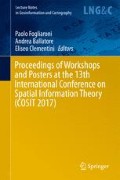Abstract
Spatial navigation by humans and other animals engages representations of environmental boundaries as well as featural landmarks. In this paper we examine the use of these two types of information using a virtual reality (VR) task in patients with Williams syndrome (WS), a genetic disorder involving abnormalities in brain regions that support spatial cognition. Our preliminary data suggests that boundary-based navigation is more fragile in this syndrome, compared to control subjects matched for mental and chronological age.
Access this chapter
Tax calculation will be finalised at checkout
Purchases are for personal use only
References
Deuker L, Bellmund JL, Navarro Schröder T, Doeller CF (2016) An event map of memory space in the hippocampus. Elife 5
Doeller CF, Burgess N (2008) Distinct error-correcting and incidental learning of location relative to landmarks and boundaries. Proc Natl Acad Sci USA 105:5909–5914
Doeller CF, King JA, Burgess N (2008) Parallel striatal and hippocampal systems for landmarks and boundaries in spatial memory. Proc Natl Acad Sci USA 105:5915–5920
Ferrara K, Landau B (2015) Geometric and featural systems, separable and combined: evidence from reorientation in people with Williams syndrome. Cognition 144:123–133
Ferrara K, Park S (2016) Neural representation of scene boundaries. Neuropsychologia 89:180–190
Keinath AT, Julian JB, Epstein RA, Muzzio IA (2017) Environmental geometry aligns the hippocampal map during spatial reorientation. Curr Biol 27(3):309–317
Lakusta L, Dessalegn B, Landau B (2010) Impaired geometric reorientation caused by a genetic defect. Proc. Natl. Acad. Sci. USA 107:2813–2817
Lee SA (2017) Curr Opin Behav Sci 58–65
Lee SA, Spelke ES (2010) Two systems of spatial representation underlying navigation. Exp Brain Res 206(2):179–188
Lee SA, Shusterman A, Spelke ES (2006) Reorientation and landmark-guided search by young children: evidence for two systems. Psychol Sci 17(7):577–582
Lee SA, Sovrano VA, Spelke ES (2012) Navigation as a source of geometric knowledge: young children’s use of length, angle, distance, and direction in a reorientation task. Cognition 123(1):144–161
Lee SA, Vallortigara G, Flore M, Spelke ES, Sovrano VA (2013) Navigation by environmental geometry: the use of zebrafish as a model. J Exp Biol 216(Pt 19):3693–3699
Libertus ME, Feigenson L, Halberda J, Landau B (2014) Understanding the mapping between numerical approximation and number words: evidence from Williams syndrome and typical development. Dev Sci 17(6):905–919
Maguire EA, Gadian DG, Johnsrude IS, Good CD, Ashburner J, Frackowiak RSJ, Firth CD (2000) Navigation-related structural change in the hippocampi of taxi drivers. Proc Natl Acad Sci USA 97:4398–4403
Martens MA, Wilson SJ, Reutens DC. (2008). Research Review: Williams syndrome: a critical review of the cognitive, behavioral, and neuroanatomical phenotype. J Child Psychol Psychiatry 49(6):576–608
Meyer-Lindenberg A, Kohn P, Mervis CB, Kippenhan JS, Olsen RK, Morris CA, Berman KF (2004) Neural basis of genetically determined visuospatial construction deficit in Williams syndrome. Neuron 43(5):623–631
Meyer-Lindenberg A, Mervis CB, Sarpal D, Koch P, Steele S, Kohn P, Marenco S, Morris CA, Das S, Kippenhan S (2005) Functional, structural, and metabolic abnormalities of the hippocampal formation in Williams syndrome. J Clin Invest 115:1888–1895
Park S, Konkle T, Oliva A (2015) Parametric coding of the size and clutter of natural scenes in the human brain. Cereb Cortex 25(7):1792–1805
Wang RF, Spelke ES (2002) Human spatial representation: insights from animals. Trends Cogn Sci 6(9):376
Author information
Authors and Affiliations
Corresponding author
Editor information
Editors and Affiliations
Rights and permissions
Copyright information
© 2018 Springer International Publishing AG
About this paper
Cite this paper
Mastrogiuseppe, M., Umeh, V.C., Lee, S.A. (2018). Spatial Navigation by Boundaries and Landmarks in Williams Syndrome in a Virtual Environment. In: Fogliaroni, P., Ballatore, A., Clementini, E. (eds) Proceedings of Workshops and Posters at the 13th International Conference on Spatial Information Theory (COSIT 2017). COSIT 2017. Lecture Notes in Geoinformation and Cartography. Springer, Cham. https://doi.org/10.1007/978-3-319-63946-8_18
Download citation
DOI: https://doi.org/10.1007/978-3-319-63946-8_18
Published:
Publisher Name: Springer, Cham
Print ISBN: 978-3-319-63945-1
Online ISBN: 978-3-319-63946-8
eBook Packages: Earth and Environmental ScienceEarth and Environmental Science (R0)

